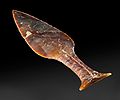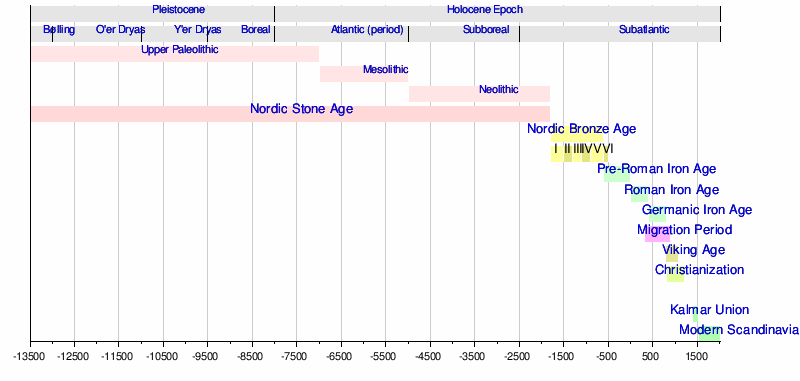Nordic Stone Age
This article has multiple issues. Please help or discuss these issues on the talk page. (Learn how and when to remove these template messages)
|
| Part of a series on |
| Scandinavia |
|---|
 |
|
The Nordic Stone Age refers to the Stone Age of Scandinavia. During the Weichselian glaciation (115,000 - 11,700 years ago), almost all of Scandinavia was buried beneath a thick permanent ice cover and the Stone Age came rather late to this region. As the climate slowly warmed up at the end of the ice age, nomadic hunters from central Europe sporadically visited the region, but it was not until around 12,000 BCE before permanent, but nomadic, habitation took root.
Late Upper Paleolithic[]
This section does not cite any sources. (December 2020) |

As the ice receded, reindeer grazed the emerging tundra plains of Denmark and southernmost Sweden. This was the era of the Hamburg culture, tribes who hunted over territories 100,000 km² vast and lived as nomads in teepees, following the reindeer seasonal migrations across the barren tundra. On this land there was little plant cover, except for occasional arctic white birch and rowan. Slowly a taiga forest appeared.
Around 11,400 BCE, the Bromme culture emerged in Southern Scandinavia. This was a more rapidly warming era providing opportunity for other substantial hunting game animals than the ubiquitous reindeer. As former hunter-gather cultures, the Bromme culture was still largely dependent on reindeer and lived a nomadic life, but their camps diversified significantly and they were the first people to settle Southern Scandinavia (and the Southern Baltic area) on a permanent, yet still nomadic, basis.
Local climate changes around 10,500 BCE, initiated both cultural changes and the first settling of the northern parts of Scandinavia. Initially, a thousand year long climate cooldown replaced the taiga with the former tundra and the local culture reverted to former times focus on the reindeer hunt. This culture is now referred to as the Ahrensburg culture. Around 9,500 BCE, the local climate warmed yet again, as the pre-Boreal era emerged, and this triggered the Ahrensburg to settle the emerging tundra of northern Scandinavia. For the next two thousand years, the climatic phase known as the Boreal reigned in the Scandinavian region.
Mesolithic[]
In the 7th millennium BCE, the climate in Scandinavia was warming as it transitioned from the former Boreal age to the Atlantic period. Reindeer and their hunters had already migrated and inhabited the lands of northern Scandinavia, and forests had established. A culture called the Maglemosian culture lived in the areas of Denmark and southern Sweden. To the north, in Norway and along the coast of western Sweden, the Fosna-Hensbacka culture was living mostly in changing seasonal camps along the shores and close to the now thriving forests. Utilizing fire, boats and stone tools, these Stone Age tribal cultures managed to survive in northern Europe. The northern hunter-gatherers followed the herds and the salmon runs, moving south during the winters, moving north again during the summers. These early peoples followed cultural traditions similar to those practiced throughout other regions in the far north – areas including modern Finland, Russia, and across the Bering Strait into the northernmost strip of North America (comprising portions of today's Alaska and Canada).
During the 6th millennium BCE, the climate of Scandinavia was generally warmer and more humid than today and the southern regions were clad in lush temperate broadleaf and mixed forests. Large animals like aurochs, wisent, moose and red deer roamed freely in the forests and were game for tribes of what we now call the Kongemose culture. Like their predecessors, the Kongemose tribes also hunted marine animals such as seals and fished in the rich shallow waters. North of the Kongemose people, lived other hunter-gatherers in most of southern Norway and Sweden, now dubbed the Nøstvet and Lihult cultures, descendants of the Fosna and Hensbacka cultures. By the end of the 6th millennium BCE, as the sea levels rose gradually, these northerly tribal cultures continued their way of life, while the Kongemose culture was replaced by the Ertebølle culture, adapting to the climatic changes affecting their low lying southern regions more severely.[1]
Genetic analysis of human remains has shown that the hunter-gatherers living in the south and north of Scandinavia formed two genetically distinct groups who arrived into Scandinavia in at least two separate waves of migration.[2] In the south and south-east, Western Hunter-Gatherers arrived from modern-day Germany and moved northwards. In the north and west Eastern Hunter-Gatherers, related to people from the Upper Volga region in modern-day Russia settled, and moved southwards. These people intermixed in Scandinavia and formed a unique group of Scandinavian Hunter-Gatherers.
Neolithic[]

During the 5th millennium BCE, the Ertebølle people learned pottery from neighbouring tribes in the south, who had begun to cultivate the land and keep animals. Soon, they too started to cultivate the land and, ca 4000 BCE, they became part of the megalithic Funnelbeaker culture. During the 4th millennium BCE, these Funnelbeaker tribes expanded into Sweden up to Uppland. The Nøstvet and Lihult tribes learned new technology from the advancing farmers, but not agriculture, and became the Pitted Ware cultures, towards the end of the 4th millennium BCE. These Pitted Ware tribes halted the advance of the farmers and pushed them south into south-western Sweden, but some say that the farmers were not killed or chased away, but that they voluntarily joined the Pitted Ware culture and became part of them. At least one settlement appears to be mixed, the Alvastra pile-dwelling.
It is not known what language these early Scandinavians spoke, but towards the end of the 3rd millennium BCE, they were overrun by new tribes who many scholars think spoke Proto-Indo-European (or more exactly, the "Pre-Germanic Indo-European" dialect), the Corded Ware culture (known as the Battle-Axe culture in Scandinavia [3]). The genetic history of Europe connects the people carrying the language with the Yamnaya culture emanating from present day Ukraine, using Haplogroup R1a as an important genetic marker.[4] This new people advanced up to Uppland and the Oslofjord, and they probably provided the language that was the ancestor of the modern Scandinavian languages. These new tribes had the battle axe as a status symbol and were cattle herders and with them most of southern Scandinavia entered the Neolithic. Ultimately, the Bronze Age would usher in a time of cultural advance in Scandinavia.

Pottery (Skarp Salling Vessel, c.3200 BCE)
Harpoon head of bone
"Thick-neck axe" from Närke, a flintstone axe characteristic of both the Funnelbeaker and the Pitted Ware cultures.

Axe head, polished stone

Doubleedged battle axe head in porphyry
Ceremonial axe head (Alunda moose)

The Hindsgavl Dagger, a c.30 cm flint dagger (c.1800 BCE). Inspired by the European Bronze Age cultures.

Passage graves (Klekkende Høj, Denmark)
Notes and references[]
- ^ See Doggerland as an extreme example of the consequence of the rising sea levels.
- ^ Günther, Torsten; Malmström, Helena; Svensson, Emma M.; Omrak, Ayça; Sánchez-Quinto, Federico; Kılınç, Gülşah M.; Krzewińska, Maja; Eriksson, Gunilla; Fraser, Magdalena; Edlund, Hanna; Munters, Arielle R. (2018-01-09). Barton, Nick (ed.). "Population genomics of Mesolithic Scandinavia: Investigating early postglacial migration routes and high-latitude adaptation". PLOS Biology. 16 (1): e2003703. doi:10.1371/journal.pbio.2003703. ISSN 1545-7885. PMC 5760011. PMID 29315301.
- ^ Malmström, Helena; Günther, Torsten; Svensson, Emma M.; Juras, Anna; Fraser, Magdalena; Munters, Arielle R.; Pospieszny, Łukasz; Tõrv, Mari; Lindström, Jonathan; Götherström, Anders; Storå, Jan (2019-10-09). "The genomic ancestry of the Scandinavian Battle Axe Culture people and their relation to the broader Corded Ware horizon". Proceedings of the Royal Society B: Biological Sciences. 286 (1912): 20191528. doi:10.1098/rspb.2019.1528. PMC 6790770. PMID 31594508.
- ^ https://www.svt.se/nyheter/vetenskap/ny-dna-forskning-visar-att-svenskar-framforallt-harstammar-fran-ukraina
Bibliography[]
- T. Douglas Price (4 April 2015): "Ancient Scandinavia: An Archaeological History from the First Humans to the Vikings", Oxford University Press
- Marek Zvelebil (2009): "Hunters in Transition: Mesolithic Societies of Temperate Eurasia and Their Transition to Farming", Cambridge University Press
- Nordic Stone Age
- Germanic archaeological cultures
- Archaeological cultures of Eastern Europe
- Archaeological cultures of Northern Europe
- Prehistoric Scandinavia
- Stone Age Europe







